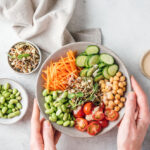Are chickpeas the ultimate superfood you have been missing out on?
 (NaturalHealth365) Nutritionists and natural healers have long held chickpeas in high regard due to their undeniable merit as a superfood. These versatile little legumes boast a delicate, nutty flavor and a pleasing consistency and are packed with high-quality plant protein, soluble and insoluble fiber, and beneficial polyunsaturated fatty acids.
(NaturalHealth365) Nutritionists and natural healers have long held chickpeas in high regard due to their undeniable merit as a superfood. These versatile little legumes boast a delicate, nutty flavor and a pleasing consistency and are packed with high-quality plant protein, soluble and insoluble fiber, and beneficial polyunsaturated fatty acids.
However, recent studies have revealed that there is much more to chickpeas than their nutritional value. Chickpeas, also known as garbanzo beans, Egyptian peas, ceci beans, and chana, combat life-threatening diseases – on four different fronts. As researchers come forward to credit chickpeas with life-extending effects, they are beginning to better understand how these tasty little morsels work their magic.
Chickpeas can naturally suppress appetite and help us maintain a healthy body weight
A single cup of garbanzo beans contains a whopping 12 grams of fiber and 15 grams of protein – a combination that slows gastric emptying and helps to create a feeling of fullness. This high protein and fiber content inhibits the production of ghrelin, a “hunger” hormone that causes increased appetite. And this isn’t all: simultaneously, garbanzo beans promote the release of cholecystokinin, a hormone that promotes a feeling of fullness – allowing them to control appetite and deliver a real one-two punch against food cravings and overeating.
Clinical studies have supported chickpeas’ appetite-suppressant effects. In one 20-week study, participants were told to eat their regular diet without attempting to modify their choices or cut calories. For 12 weeks during the study, the volunteers were told to add garbanzo beans to their diet. Amazingly, during the garbanzo bean phase, participants reduced caloric intake and instinctively chose to eat smaller amounts of salt and sugar-laden processed foods.
A delicious way to avoid heart disease
Chickpeas significantly reduce levels of LDL, or low-density lipoproteins, in the bloodstream. This delicious food works against LDL in two different ways: by lowering the amount of circulating LDL in your blood and slowing the rate of LDL oxidation.
In addition, this bean is high in folate, a B vitamin that combats homocysteine, an amino acid associated with inflammation and increased heart attack risk. Finally, chickpeas are rich in manganese and magnesium, both of which support healthy blood pressure – a definite benefit for your heart.
Looking for a natural way to stabilize blood sugar and ward off type 2 diabetes?
Chickpeas can improve blood sugar levels both immediately and long-term – if consumed regularly. Thanks to their very low glycemic index, this legume will help prevent dangerous blood sugar surges, thus helping to ward off diabetes. In fact, the glucose response of chickpeas is only 45 percent that of cereal and pasta.
Chickpeas are rich in natural sugars and starch – two substances many have been conditioned to think of as “bad.” However, researchers have found that amylase – the starch found in chickpeas – reduces blood sugar and insulin levels in diabetics and non-diabetics alike. And, raffinose found in chickpeas – a combination of galactose, fructose, and glucose – encourages the development of healthy gut flora.
Enhance your health with this versatile superfood
Regarding disease prevention, organic dried chickpeas are your best bet. The small, dark “desi”-type beans are even richer in antioxidants than the more common cream-colored “kabuli” beans, but both types provide a wealth of health benefits.
To prepare dried chickpeas, soak them overnight, discard the water, add fresh water, and simmer them – along with fresh garlic or onion – for about 90 minutes or until tender. Usually, 1 and half cups of water for every cup of dry beans is perfect for cooking beans. If you crave more crunch, try roasting your chickpeas before cooking them.
The delicate flavor of chickpeas allows them to blend well with practically everything. Sprinkle them in salads, soups, or your favorite entree. Of course, you can also make hummus – since chickpeas are the primary ingredient of this Mediterranean delight.
Sources for this article include:



